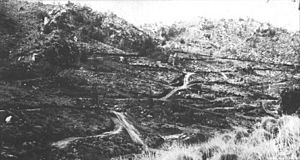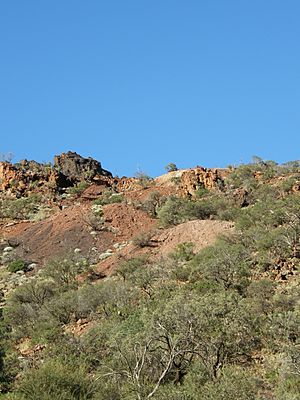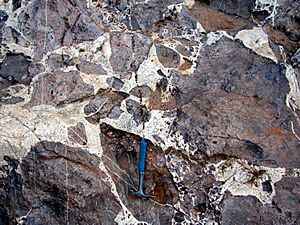Mount Gee facts for kids
Quick facts for kids Mount Gee |
|
|---|---|
| Highest point | |
| Elevation | 640 m (2,100 ft) AHD |
| Geography | |
| Location | South Australia, Australia |
| Parent range | North Flinders Ranges |
Mount Gee is a special mountain in the northern Flinders Ranges of South Australia. It's found inside the Arkaroola Wilderness Sanctuary. The mountain was named after a mining official called Lionel Gee.
Between 2008 and 2011, Mount Gee became well-known. This was because companies wanted to look for uranium there. Many people thought this area was already protected from mining. But in 2011-2012, the South Australian Government stepped in. They created the Arkaroola Protection Zone. A new law, the Arkaroola Protection Act (2012), now stops all mining in this special zone.
Contents
What Makes Mount Gee Special?
Mount Gee's peak rises 600 metres above sea level. It is one of many peaks in a beautiful area. This area is north-east of the Gammon Ranges. It is also south of the Mawson Plateau.
Mount Gee was added to the Register of the National Estate in 1982. This was because of its amazing quartz crystals. These crystals line the inside of special rock formations.
A Look at Mount Gee's History
People started looking for minerals in the Mount Painter area in the 1860s. They found copper at places like the Yudnamutana copper field. There were also many small digging sites around Mount Painter.
In 1910, Professor Sir Douglas Mawson found something new. He identified samples of torbernite. This is a mineral that contains copper and uranium. The samples were brought to him from what is now called Radium Ridge.
From 1911 to 1935, groups tried to get radium from Radium Ridge. This area is right next to Mount Gee. During World War II, the government explored the Mount Gee-Mount Painter area. They developed the No.6 workings, shown in the photo.
More exploration happened in the 1950s. Then, in the late 1960s and early 1970s, companies like Exoil NL and Transoil NL explored the area. They built the "Ridgetop" track. Many other exploration tracks on Mount Gee were also built then.
Exploration stopped in the 1970s. This was because large uranium deposits were found elsewhere. Also, the government introduced a "Three mine policy".
In the early 1990s, CRA started exploring again. They focused on areas north of Mount Gee. Later, Bonanza Gold Ltd and Marathon Resources continued the search. They drilled many holes around Mount Gee.
Marathon Resources claimed that Mount Gee has a large uranium deposit. They said it could be the sixth largest in Australia. However, none of these uranium deposits have been profitable to mine.
Protecting Mount Gee
Mount Gee is located in the Arkaroola Protection Zone. This zone is part of the Arkaroola pastoral lease. Reginald and Griselda Sprigg bought this land in 1967. Their goal was to protect wildlife and the environment.
The South Australian Government recognized this goal. In 1996, the property became an official wilderness sanctuary. This protection was made even stronger. The Mount Gee area was included in the "Environmental Class A Zone."
This zone aims to protect the natural environment. It also protects the landscape from mining damage. Mining is only allowed in this zone if it's extremely important. It must be in the highest national or state interest. This means other environmental concerns could be set aside.
In 2012, the South Australian government passed the Arkaroola Protection Act. This law completely bans all mining activities in the entire Arkaroola Protection Zone. This includes Mount Gee and the Mount Painter area.
Recent Events at Mount Gee
In 2007, a mining company called Marathon Resources wanted to mine uranium at Mount Gee. They planned an underground mine. This mine would have tunnels leading to processing facilities far away. The owners of Arkaroola Wilderness Sanctuary did not support this plan. Many conservation groups also opposed it.
In January 2008, environmental problems were found at Mount Gee. An investigation by the South Australian Government took place. They found that a drilling company had buried a lot of waste. This included plastic bags, drilling materials, and other rubbish.
Marathon Resources admitted that drums of samples were also buried. There was also evidence that fluorite samples were taken from Mount Gee. However, it's not clear if Marathon or its workers were responsible for this. People have been collecting mineral specimens from Mount Gee for a long time.
Because of this, the government suspended Marathon Resources' exploration license. Marathon then worked hard to clean up the dumped rubbish. They also tried to fix the drill sites and tracks.
In October 2009, the government gave Marathon Resources another exploration license. But after more exploration, the Arkaroola Protection Act was passed in 2012. This law stopped all mining activity in the area. Marathon Resources received some money from the government as compensation.





